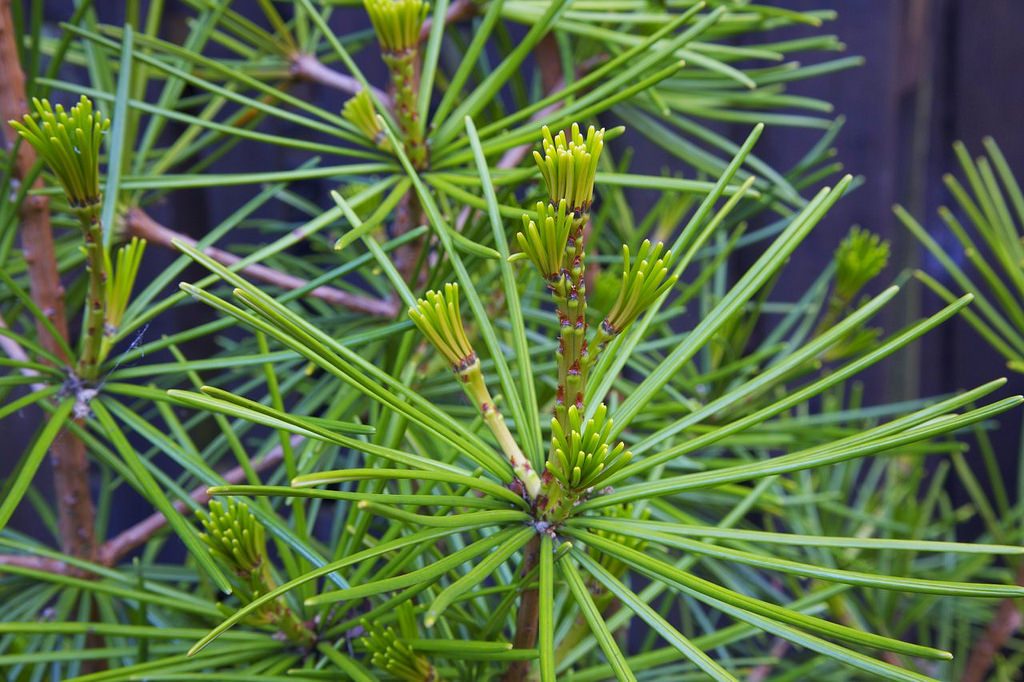Japanese Umbrella Pine
The Japanese Umbrella Pine (Sciadopitys verticillata), or Koyamaki, is an evergreen conifer native to Japan, not actually a pine. It is the only member of both its family and genus. It has no known relatives in the plant world and the oldest fossil found dates back to 230 million years ago, making it prehistoric. Its genus name comes from the Greek words for “shadow” and “pine,” and its species name means “with whorls.” It can reach a towering eighty-eight feet in height in the wild and thirty feet in cultivars, with brown main shoots bearing whorls of long cladodes that look like the spokes of an umbrella. The cladodes perform the function of leaves, but are actually composed of stem tissue. The tree also bears stumpy cones with flat scales that are about four inches when they reach maturity at eighteen months. They do not look like typical pine tree cones. The trees are dense and compact when young, but grow into pyramidal and sometimes spire-like adult forms. Many trees have multiple trunks and are very slow growing (only about six inches a year), but long lived.

Japanese Umbrella Pines are popular as specimen or lawn trees, but they can be expensive to purchase because they are uncommon and slowly catching on in the US. They make great accents and looked good in rock and conifer gardens. Rich, moist, slightly acidic soils are best and full sun is required. They came originally from the famed Japanese cloud forests, which have high rainfall and humidity, but cool temperatures, so they do not tolerate drought or extreme heat. Their dense foliage makes them susceptible to snow and ice damage and they can also get wind burn. They are propagated by seed or with dormant season cuttings. If working with cuttings, rooting is very slow. They will perform in USDA zone 5, and have mixed results in zone 4. In zones 6 through 8, they sometimes need protection from midday sun.
There are a few notable cultivars. The most prized and unusual is called “Aurea” or “Ossorio Gold” and features golden yellow needles, instead of green. The “Pendula” is extremely rare and has weeping branches. “Variegata” has multicolored green and yellow needles.
Baltic amber, or succinite, which is amber dating back to 44 million years ago in the Eocene era was thought to have been produced by the tree Pinites succinifer, but actually was produced by trees in the Sciadopityaceae family. Infrared microspectroscopy analysis of the resin produced by the Japanese Umbrella Pine lead scientists to this conclusion. Numerous extinct species of both plants and animals have been found encased in Baltic amber.

The Japanese Umbrella Pine was first introduced to Europe in the 1860s by John Gould Veitch, a horticulturalist and traveller. He was one of the first “plant hunters” to visit Japan. The name “umbrella pine” was probably coined during the Civil War by Boston historian Francis Parkman. Parkman is credited with being the first gardener to grow the Japanese Umbrella Pine outside of Japan. George Hall, a doctor turned Oriental trader, sent Parkman a shipment of plants in 1861, which included the Umbrella Pine as well as the first Japanese Maple. More recently, the tree was chosen for the Imperial crest of Prince Hisahito of Akishino, who is currently third in line for the throne in Japan.



